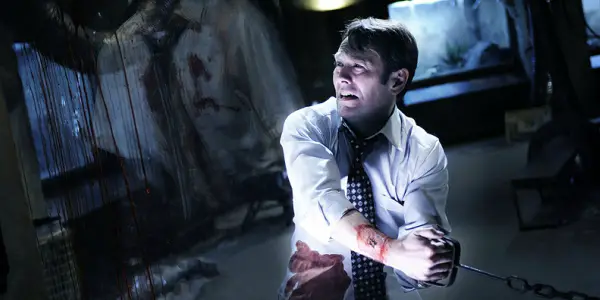Just two weeks away from Jigsaw, we only two more films to look at as our exploration of the franchise almost comes to an end. If you missed the other reviews be sure to check them out but for now, let’s look at Saw VI.
With five movies in, the Saw films are quickly losing steam. Their formulaic nature and boring side-plot make those couple of last films real disasters. By this time, it’s clear that the Saw franchise should have ended a long time ago. So, it’s with genuine surprise that Saw VI seems to have learned from previous entries and with a new plot of its own, it manages to be the stand out of the franchise.
Two Things A Saw Movie Needs
A big criticism of the previous films, I found, was that they just didn’t seem to capture the essence of what made Saw famous in the first place. So, it’s surprising that six movies in they finally reintroduce two of the elements missing from the other films. The first is the suspense surrounding the main event. IV and V have spent a lot of time setting up Mark Hoffman as the successor to Jigsaw, but they never establish him as a compelling villain. In VI, the police are cracking down on Jigsaw’s plan, and some of the evidence just don’t fit in the narrative Hoffman is trying to pass. This investigation creates suspense and finally gives stakes to the villain.

Although his twist revealing him as Jigsaw didn’t work in IV, here the twists are actually clever and surprising once again. After being stale and dry, the twists are re-energized and feel like they add layers to the story and characters. Just like the first two, it rewards the rougher parts of the story while changing the whole dynamic of the characters. The Saw films go a long way with unpredictable and fascinating twists.
Fun vs. Uninspired
The most baffling choices in Saw VI are the ones that betray the overall ethical principle of the franchise. You would assume that the coming films would follow such rules. But here, victims are brought into the trials, not because of something they did, but because they are related to the main character. This means that innocent people are left to die and for what purpose? It’s clear that VI wants red herrings and nothing more. However, to betray what was brought upon in the other films seem careless even for Saw.
It’s not like the Saw films are known for their careful nature and inspired plots but VI‘s games, although fun, are never truly inventive. There is a game where characters are to hold their breath longer than the other. It’s a typical game with not many stakes, even with the added Saw twist. It’s not particularly cinematic and it seems quite silly when compared to the other games. Another game reveals Saw‘s version of musical chairs which is more suspenseful than the other game but ultimately, silly. It also represents another game where innocent characters die for no purpose but to have blood. The games aren’t very inspired but on the bright side, they are at least grounded in some reality.
An Attack On The U.S Healthcare System
Though Saw VI is uninspired with its games, it surprisingly has something on its mind. VI is, at its core, an attack on the U.S healthcare system. It’s a good concept considering the whole reason the Saw franchise exist is a failure of the medical system. The film finally explores how the system has let down our killer and the whole reason that made him crazy in the first place. In a sense, it’s an origin story for Jigsaw and it changes the pace for the whole franchise. Instead of focusing on the boring police investigation, VI focuses on this health care story, which is far more interesting.
However, as smart of a direction as it may be for a Saw film, it’s still, well, a Saw film. The metaphor works at first, but, as it develops, quickly misses the point. The film doesn’t seem to realize that healthcare is a system and Jigsaw faced a systematic failure. To get its revenge, VI offers to kill some of the people within this system as a means to change. But killing these people will not lead to change and VI doesn’t seem to look past its narrow view of healthcare. Torturing doctors won’t do any damage to the flawed system. Instead, it takes innocent people who are actively doing their jobs and traumatizes them to no real effect. However, a Saw film tackling a system wouldn’t necessarily be something fans would want to see.
Saw VI: Conclusion
For all the talk of redemption, Saw VI is the only one to actually walks the walk. And while it may be a wobbly walk, this sequel gets just enough right to make its existence worthwhile. As a Saw film, it’s much better than any of the previous entries. However, as a metaphor for health care, it’s a hit and miss, which pretty much sums up this franchise’s entire life. Even if you find this film mediocre, you can’t overlook its attempt at being better and for fans of Saw‘s twists, you can’t overlook this one.
What are your thoughts on Saw VI’s attack on health care?
Saw VI came out in theatres on October 23, 2009.
Does content like this matter to you?
Become a Member and support film journalism. Unlock access to all of Film Inquiry`s great articles. Join a community of like-minded readers who are passionate about cinema - get access to our private members Network, give back to independent filmmakers, and more.